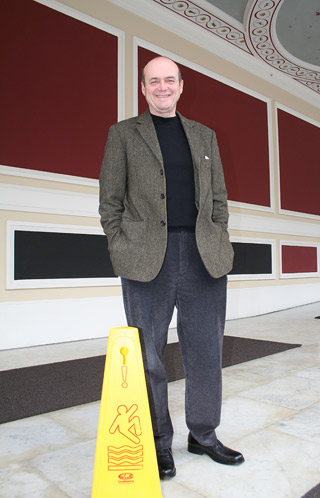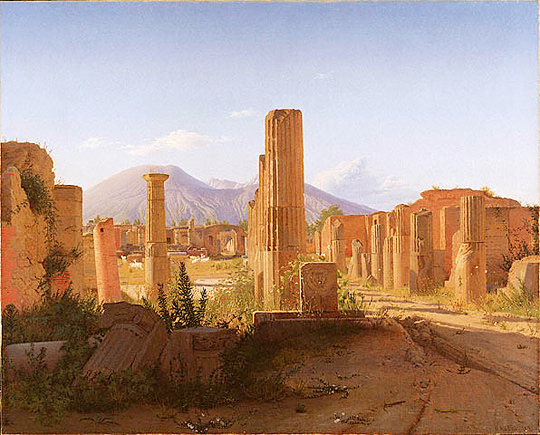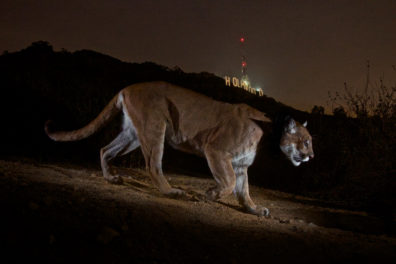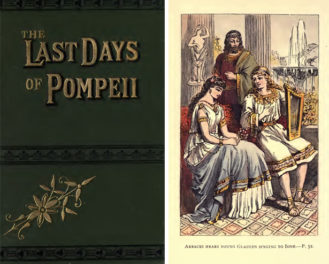
Canadian archaeologist Alexander “Sandy” MacGillivray studies disasters for a living. He’s an expert on one of the worst cataclysms in history, the eruption of the volcano on Thera (present-day Santorini, Greece) around 1500 B.C. Thera blackened the world’s skies, sent tsunamis as far as Egypt and the Levant, and led to the untimely end of the Minoan civilization of Crete. Some even say it caused the Ten Plagues of Egypt.
Dr. MacGillivray recently visited the Getty Villa to present his research about Thera. I spoke to him about global warming, the Minoans, the Black Plague, the legend of Atlantis, and life in L.A. after the Big One.
Why are people so fascinated by disaster?
You’re living on pretty active fault lines in L.A. That’s one of the reasons people here are interested in disaster.
Globally, people are interested because of rising sea levels caused by global warming. People are aware that there’s an impending ecological disaster and are trying desperately to avert it. That’s why Atlantis is a buzzword right now. Atlantis was a high culture like our own that was wiped out in one day.
As an archaeologist, I view these things over the long term. Where I work in Crete, part of the town and harbor from the Minoan period is under two meters of water. I can look down the street in New York and easily see it under water.
You’ve been studying the eruption of Thera for years. How does it compare to disasters that have come since?
It was the biggest eruption in historical times. Because it was in a small and enclosed area—not the middle of the Pacific Ocean, say—it impacted everything around it. And now we’re finding that it affected world weather for years afterward.
The ash from the eruption of Thera covered the whole world. We’re even finding it in Arctic ice. Some people even think they see references to the eruption in Chinese texts. There were several years of winter: darkness, very little sun, lots of rain, and very different plant growth patterns. It created a global winter for years.
So Thera was larger in scale than the eruption of Mount Vesuvius in A.D. 79, which buried Pompeii and Herculaneum?
Much, much larger. Vesuvius wiped out Herculaneum and Pompeii and buried them forever. There was a town on Thera buried at the time of the eruption, but the eruption itself was much larger than Pompeii.

Pompeii in ruins: The Forum at Pompeii with Vesuvius in the Background, Christen Schjellerup Købke, 1841
Did Thera completely destroy the Minoans?
They continued for a couple of generations. In fact, right after the disaster, the people in central Crete and Knossos who were least affected began rebuilding their monuments, probably with a lot of money from Egypt.
The Minoans got money from Egypt? Why?
After the disaster, the Minoans went to Egypt asking to become vassals of Hatshepsut. When Hatshepsut died, though, they were left unprotected—just long enough for the Mycenaean Greeks to come in and conquer them.
You appear in “Sinking Atlantis,” an episode of the PBS series Secrets of the Dead. The episode hints that the Minoans were a “cursed” civilization. Were they?
When the Greeks took over Minoan Crete, what they remember is cannibalism, human sacrifice, and feeding kids to the Minotaur. To them, the Minoans were incredibly evil.
Was this a justification for the conquest of Crete?
We have found evidence for cannibalism, and the Greeks remember it in so many places that it probably did take place. But it wasn’t cannibalism out of hunger. It was eating a person because of what you wanted to get from them. You would eat an elite person who might be descended from the gods.
The Greeks just don’t have a kind word to say about the Minoans. Although, perhaps this was like the invasion of Iraq and Afghanistan—a justification for invading.
Some people say that Crete was Atlantis. Was it?
I don’t think Crete could have been Atlantis, because Plato would have known about it. Plato says Atlantis is beyond “the Pillars of Hercules,” which is Gibraltar—so I think he was fairly adamant that it was in the Atlantic.
So Atlantis is out there, waiting to be found?
I think so. A retired British Royal Navy cartographer came to visit us in eastern Crete and told us, “No, Crete isn’t Atlantis. We found Atlantis when we were doing topographical maps off Portugal. But they took it off our maps.” So I thought, if someone like Robert Ballard goes out there one day, he might find something.
Like us, the Minoans had their primary settlements along the coast. Then they were decimated by a cataclysmic wave. Could this happen here?
The parallels are striking, especially sitting here at the Getty Villa, which is like a small recreation of the Bay of Naples. It’s asking for trouble!
Should we worry?
(Jokingly) Know where the nearest high ground is in the event of a tsunami.
No one wants a disaster. And yet, if Vesuvius hadn’t erupted, there would be no Getty Villa—because there would be no preserved Villa dei Papiri to model it on. Ironically, Pompeii and Herculaneum were preserved in part because they were destroyed.
That’s one of the main reasons it fascinates us. The fact that we’re talking about this here, at the Villa, is interesting. J. Paul Getty was attempting to revive a golden age of Roman life. He was obsessed with the Roman emperor Hadrian, who introduced a great period of the revival of the arts. But of course, that all vanished into late antiquity. Everything vanishes and is lost.
Take L.A., for example, with Hollywood and the movies. In 100 years, there may not even be devices to watch those movies.
There are pockets of time and space where people do wonderful things, but these things often come after horrible things, and end with equally horrible things.
Do disasters ever bring positive changes?
Disasters are often preceded by social discontent, and can sometimes help to redress these problems. For example, in Europe leading up to the Black Death and the Hundred Years’ War there were enormous social inequalities and problems, which were in fact solved by the Plague.
And look at what came after the Plague: the Renaissance and a whole new way of thinking, a new appreciation of people in general, not just the elite. So many people are wiped out in a disaster that a lot of the class distinctions are erased.
You’ve said you hate disasters, yet you continue to study them. Why?
Disasters are painful, and I would rather not know about them. But once you do know about a disaster, you have to figure out why you know about it and what it was meant to teach us.
As a kid in Quebec, there were bombers flying from the U.S. to Russia right over my head. My friends and I had this incredible sense of impending doom.
Yet, when you look over the long term, you see how people go though these periods and create something new afterwards. Unless you’re Cormac McCarthy writing The Road—when it’s over, it seems totally over!
There is something at the end of the road, then.
There always is, even if it’s not human. The grass and the cockroaches will grow again. Something will survive. Humans can live in the Arctic and in the jungle; we can live anywhere. We always survive.
So we shouldn’t worry too much about the Big One that will turn L.A. into a floating island?
(Laughing) Well, there’ll be a lot more beachfront property.
Text of this post © J. Paul Getty Trust. All rights reserved.




It’s great that historians and archelogist sought to learn disasters in the past in order to discover their affects and try to find ways to prevent or prepare for them. Since there has been very many talks about California being hit with a large earthquake, I do feel that people only start to prepare for disaster when disaster happens, by then it’s too late.